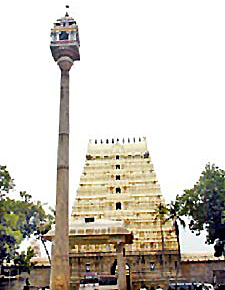 The inscription engraved on the temple of Sri Bhuvarasvami enhances the antique significance of the temple. A large number of ancient inscriptions are seen on the walls of this temple. The inscriptions carved on the temple walls point to the chronological significance of the temple. The inscriptions in fact are the evidence to determine the period when the temple was constructed. From the inscriptions it is known that the Bhuvarahasvami temple was in existence even during the Chola period of the 11th century A.D. It is known from an epigraph of king Vira-Rajendra Chola dated 1068 A.D. inscribed in a wall at a nearby place of the Siva temple which registers a royal gift of a village to this Varaha shrine. Another inscription of Kulottunga Chola I dated 1100 A.D. is also found in the Siva temple. This inscription records the tale of the grant of another village to this Vishnu temple and the deity is referred to here as Sri Varaha Azhvar.
The inscription engraved on the temple of Sri Bhuvarasvami enhances the antique significance of the temple. A large number of ancient inscriptions are seen on the walls of this temple. The inscriptions carved on the temple walls point to the chronological significance of the temple. The inscriptions in fact are the evidence to determine the period when the temple was constructed. From the inscriptions it is known that the Bhuvarahasvami temple was in existence even during the Chola period of the 11th century A.D. It is known from an epigraph of king Vira-Rajendra Chola dated 1068 A.D. inscribed in a wall at a nearby place of the Siva temple which registers a royal gift of a village to this Varaha shrine. Another inscription of Kulottunga Chola I dated 1100 A.D. is also found in the Siva temple. This inscription records the tale of the grant of another village to this Vishnu temple and the deity is referred to here as Sri Varaha Azhvar.
Most of the inscriptions in the Bhuvarahasvami temple belong to the period of the Vijayanagara kings starting from the 15th century A.D. Some of the inscriptions are also the feudatories of the Vijayanagara kings. The inscriptions also narrate that some of the sub shrines of the temple constructed by the Nayaka kings. An inscription of the Vijayanagara king, Virupaksha II dated 1471 A.D is found on the walls of the temple. This inscription states the story of the gift of a village to this temple called in this epigraph as Aadivaraha Naayanar Koil. Inscriptions of other rulers like Sriranga I (1572-1585 A.D.) and Venkata II (1586-1614 A.D.), some of which are in Telugu are also found here, which depict the legendary stories associated with this Bhuvarasvami temple.
Apart from the major inscriptions described above, there are some other inscriptions, which narrate the stories of other kings associated with the Bhuvarasvami Temple. The Nayaka ruler of Tanjavur, Achyutappa Nayaka (1560-1614 A.D.) rendered great service to this temple. He was responsible for the construction of the Purushasukta mandapa and also many of the smaller shrines. He was entrusted with the task of temple administration and control of its treasury and also donated many villages for the maintenance of this temple.
The inscriptions are significant enough to denote the date of the construction of the temple and the accounts of those kings who offered their valuable contribution to the temple.





















